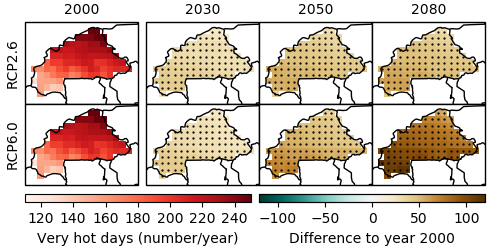[1] World Bank, “World Bank Open Data,” 2019. Online available: https://data.worldbank.org [Accessed: 31-Jan-2020].
[2] CIA, “The World Factbook: Burkina Faso,” 2019. Online available: https://www.cia.gov/library/publications/the-worldfactbook/geos/uv.html [Accessed: 30-Aug-2019].
[3] World Bank, “World Development Indicators,” 2018. Online available: https://databank.worldbank.org/source/worlddevelopment-indicators [Accessed: 09-Apr-2020].
[4] Observatory of Economic Complexity, “Burkina Faso,” 2017. Online available: https://oec.world/en/profile/country/bfa/#Exports [Accessed: 14-Apr-2020].
[5] FAO, “Socio-Economic Context and Role of Agriculture: Burkina Faso,” Rome, Italy, 2014.
[6] FAOSTAT, “Crops in Burkina Faso (Area Harvested),” 2017. Online available: http://www.fao.org/faostat/en/#data/QC [Accessed: 06-Mar-2020].
[7] UNDESA, “Trends in International Migrant Stock: Migrants by Destination and Origin,” New York, 2019.
[8] World Bank, “Migrant Remittance Inflows (US $ Million),” Washington, D.C., 2019.
[9] CONASUR, 2020, cited in: WFP Burkina Faso, “Emergency Response Situation Report #12”, 2020. Online available: https://reliefweb.int/sites/reliefweb.int/files/resources/Sit%20Rep-%20BF%20%2311.pdf [Accessed: 28-May-2020].
[10] UNDP, “Human Development Index,” 2018. Online available: http://hdr.undp.org/en/indicators/137506 [Accessed: 08-Oct-2019].
[11] Notre Dame Global Adaptation Initiative, “Burkina Faso,” 2017. Online available: https://gain-new.crc.nd.edu/country/burkina-faso [Accessed: 24-Oct-2019].
[12] FAO, IFAD, UNICEF, WFP, and WHO, “Food Security and Nutrition in the World 2019,” Rome, Italy, 2019.
[13] S. Lange, “EartH2Observe, WFDEI and ERA-Interim Data Merged and Bias-Corrected for ISIMIP (EWEMBI).” GFZ Data Service, Potsdam, Germany, 2016.
[14] World Bank, “Local Development, Institutions and Climate Change in Burkina Faso: Situation Analysis and Operational Recommendations,” Washington, D.C., 2010.
[15] B. Ampomah-Ankrah, “The Impact of Climate Change on Water Supply in the Sahel Region: The Case of Burkina Faso,” International Water Association, 2019. Online available: https://iwa-network.org/the-impact-of-climate-change-on-water-supply-in-the-sahel-region [Accessed: 31-Oct-2019].
[16] S. Traore and T. Owiyo, “Dirty Droughts Causing Loss and Damage in Northern Burkina Faso,” Int. J. Glob. Warm., vol. 5, no. 4, pp. 498–513, 2013.
[17] M. Winsor, “Drought-Hit Burkina Faso Rations Water Supply in Ouagadougou Amid Severe Shortage,” International Business Times, 2016. Online available: https://www.ibtimes.com/droughthit-burkina-faso-rations-water-supply-ouagadougou-amid-severeshortages-2363145 [Accessed: 02-Mar-2020].
[18] B. Barbier, H. Yacouba, H. Karambiri, M. Zoromé, and B. Somé, “Human Vulnerability to Climate Variability in the Sahel: Farmers’ Adaptation Strategies in Northern Burkina Faso,” Environ. Manage., vol. 43, no. 5, pp. 790–803, 2009.
[19] B. Sarr et al., “Adapting to Climate Variability and Change in Smallholder Farming Communities: A Case Study From Burkina Faso, Chad and Niger (CVCADAPT),” J. Agric. Ext. Rural Dev., vol. 7, no. 1, pp. 16–27, 2015.
[20] J. Wanvoeke, J. P. Venot, C. De Fraiture, and M. Zwarteveen, “Smallholder Drip Irrigation in Burkina Faso: The Role of Development Brokers,” J. Dev. Stud., vol. 52, no. 7, pp. 1019–1033, 2016.
[21] R. E. Namara and H. Sally, “Proceedings of the Workshop on Irrigation in West Africa: Current Status and a View to the Future,” Colombo, Sri Lanka, 2014.
[22] USAID, “Country Profile: Property Rights and Resource Governance in Burkina Faso,” Washington, D.C., 2017.
[23] USAID, “Climate Risks in Food for Peace Geographies: Burkina Faso,” Washington, D.C., 2017.
[24] USAID, “Climate Risk in Food for Peace Geographies: Kenya,” Washington, D.C., 2019.
[25] S. Dos Santos, J. P. Peumi, and A. Soura, “Risk Factors of Becoming a Disaster Victim: The Flood of September 1st, 2009, in Ouagadougou (Burkina Faso),” Habitat Int., vol. 86, no. March, pp. 81–90, 2019.
[26] M. Dabaieh, O. Wanas, M. A. Hegazy, and E. Johansson, “Reducing Cooling Demands in a Hot Dry Climate: A Simulation Study for Non-Insulated Passive Cool Roof Thermal Performance in Residential Buildings,” Energy Build., vol. 89, pp. 142–152, 2015.
[27] T. M. Shanahan et al., “CO2 and Fire Influence Tropical Ecosystem Stability in Response to Climate Change,” Nat. Publ. Gr., no. July, pp. 1–8, 2016.
[28] IPBES, “Report of the Plenary of the Intergovernmental Science-Policy Platform on Biodiversity and Ecosystem Services on the Work of Its Seventh Session,” n.p., 2019.
[29] K. Dimobe, A. Ouédraogo, S. Soma, D. Goetze, S. Porembski, and A. Thiombiano, “Identification of Driving Factors of Land Degradation and Deforestation in the Wildlife Reserve of Bontioli (Burkina Faso, West Africa),” Glob. Ecol. Conserv., vol. 4, pp. 559–571, 2015.
[30] A. Russell et al., “Using Forests to Enhance Resilience to Climate Change: The Case of the Wood-Energy Sector in Burkina Faso,” n.p., 2013.
[31] B. Simane, H. Beyene, W. Deressa, A. Kumie, K. Berhane, and J. Samet, “Review of Climate Change and Health in Ethiopia: Status and Gap Analysis,” Ethiop. J. Heal. Dev., vol. 30, no. 1, pp. 28–41, 2016.
[32] Centers for Disease Control and Prevention, “CDC in Burkina Faso,” Atlanta, Georgia, 2011.
[33] Severe Malaria Observatory, “Burkina Faso,” 2019. Online available: https://www.severemalaria.org/countries/burkina-faso [Accessed: 31-Oct-2019].
[34] E. Diboulo et al., “Weather and Mortality: A 10 Year Retrospective Analysis of the Nouna Health and Demographic Surveillance System, Burkina Faso,” Glob. Health Action, vol. 5, no. 1, p. 19078, Dec. 2012.
[35] K. Belesova, A. Gasparrini, A. Sié, R. Sauerborn, and P. Wilkinson, “Annual Crop-Yield Variation, Child Survival and Nutrition Among Subsistence Farmers in Burkina Faso,” Am. J. Epidemiol., vol. 187, no. 2, pp. 242–250, 2018.
[36] International Committee of the Red Cross, “Burkina Faso: Increased Armed Violence Means Loss of Health Care for Half a Million People,” 2019. Online available: https://www.icrc.org/en/document/burkina-faso-increased-armed-violence-means-loss-health-care-halfmillion-people [Accessed: 31-Oct-2019].




















